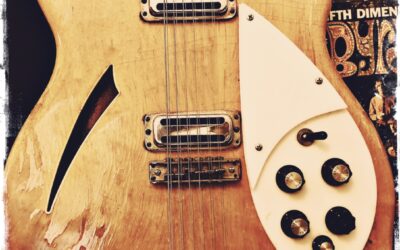Sometimes a picture will stay with you forever. I had already owned one of the first Les Paul Goldtops to arrive in Connecticut in 1968 and sold it due to its weight — I was a pretty skinny kid and it killed my shoulder.
I was not a stranger to Gibson Les Pauls. I had seen black Customs and Sunburst Standards in the hands of various rock stars, but this was something different. It did not take long to read an interview with Leslie West to discover the guitar in the Life Magazine Woodstock issue, that I had an instant love of, was a Les Paul Junior. Now, how to get one!
I made a few trips to W48th street in NYC, but no luck. There was a weekly newspaper in Connecticut named the “Bargain News” that I checked weekly. One ad seemed promising, but the guitar turned out to be a single cutaway Melody Maker. It was a very cool single pickup guitar that I got for $50, but it was not a Junior. I had $150 saved up from painting a neighbor’s garage so I was ready for one to show up. At this point in time the only Junior I had ever seen was Leslie’s, and to my knowledge that was what a Junior was.
After a while my chance to own one came. I found an ad for one in the Bargain News. The guitar was in Monroe, Connecticut, about an hour drive, but I was not going to miss my chance. My band mate Peter and I got into my VW and drove to Monroe.
When I walked into the room the first thing I noticed was it’s cool brown alligator case. I slowly opened the case. To my complete surprise the guitar looked nothing like Leslie West’s Junior. This one was red and a double cutaway, but it did say “Les Paul, Junior” on the headstock so it was a Junior. I dig it anyway, it had the appointments I liked, one pickup and a wraparound tailpiece so while not what I thought I was buying, I was happy.
At that point I had the Melody Maker and my first Junior. Shortly after that I picked up another red double cutaway at a pawn shop in New London. Because new Martin guitars had black pickguards and older ones had red “tortoise” guards, for some time I thought the red ones were older.
I finally got my first no issues sunburst single cutaway Junior on W 48th Street sometime in the summer of 1970. It would not be until around 1972 that I got my first TV Model, a 1959 double cutaway. I traded George Gruhn a Brazilian rosewood 00-28G for it.
Over the years I would own many Juniors, TV’s and Specials (two pickups). As time went on I learned more about the history of the model. I’ll share my understanding of the evolution of this model.
The Junior was introduced in 1954 as a single pickup, sunburst finish economy Les Paul. Some early examples have Maple bodies. I saw what appeared to be a prototype from 1953 at Gruhn’s awhile back. Gibson moved the position of the pickup in relationship to the treble side of the wraparound tailpiece stud because it had a bad habit of breaking through to the pickup route. In 1955 Gibson introduced the TV Model, which is identical to the Junior except for its straw blonde-like “Limed Oak” finish and black tone and volume knobs. There was a myth that the finish was created to show up better on TV, but I’ve never believed that.
At some point in 1958 the Junior and TV went through a major design change. In what appeared to be an effort the create a guitar with greater neck access, both models became a double cutaway guitar. The earliest examples in 1958 had a very “squared” off slab body. At some point in late 1958 or early 1959 the body edges were rounded and the neck heed was extended, to achieve a more stable neck joint. The Junior acquired a red finish and the TV model became a bit more yellow, and both guitars had red tortoise pickguards. Another detail was that the neck profile on the 1959 models were for lack of a better word, huge. In 1960 the neck profile became more of a thin, flat oval.
The Junior was originally introduced as an economy student grade guitar. I doubt Gibson would have ever dreamed that it would become the guitar of choice for so many and varied rock guitarists. From Leslie West, Keith Richards, John Lennon, Neil Young, Mick Jones, Johnny Thunders, Billie Joe Armstrong and many others. I venture to say almost every serious rock and roll guitarist has one in their toolbox.





0 Comments